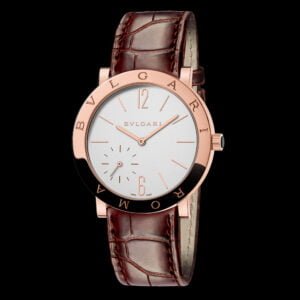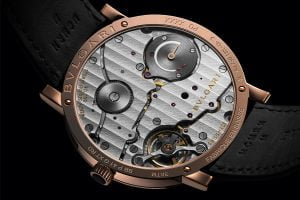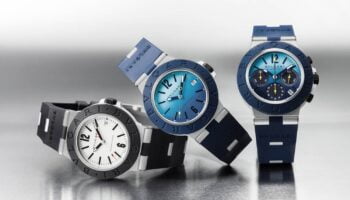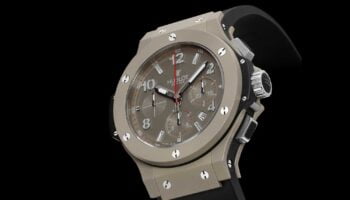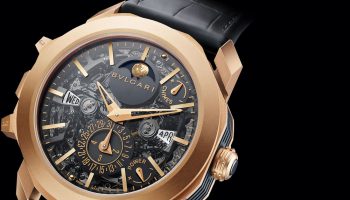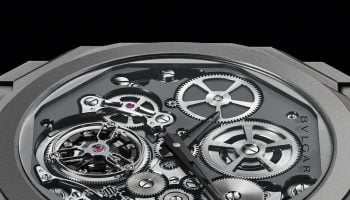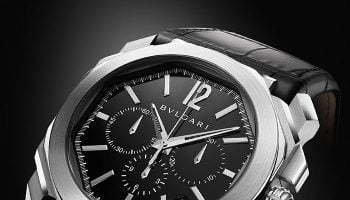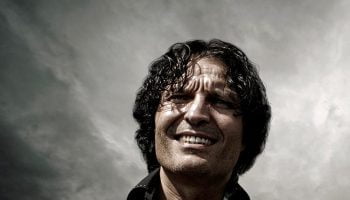This year the Bulgari Roma is celebrating its 40th birthday with, among other things, the Roma Finissimo, Bulgari Roma Tourbillon Finissimo, Bulgari Solotempo and Bulgari Roma Tubogas anniversary models. 0024 focuses on the anniversary by means of an interview with Bulgari’s Chief Watch Designer, Fabrizio Buonamassa.
My designs are never baroque; they are clear and simple
After reading your bio, Mr Buonamassa, one can’t help thinking that you are luckier than most. Born in Naples, the place in Italy where they serve the best food, offered a job with FIAT on your birthday after finishing your design studies, and you have been a designer for Bulgari these past fourteen years. What is your secret?
Fabrizio Buonamassa (FB): “Hahaha! I don’t have one. I love design and I love designing. I also love cars; they were my first passion and consequently that’s where I started. When I started at FIAT the company was nothing like today’s FIAT. For example, Alfa Romeo and Lancia were still part of the group. I started with the design of various different components and in 2001 I left FIAT to join Bulgari. In 2005 I subsequently started my own design studio in Milan. I completed assignments for various fashion houses, among other things, but I also continued to do work for Bulgari. When Bulgari eventually offered me a position as Chief Designer I couldn’t say no. The studio where the watches are designed was initially in Rome – the original home of the house of Bulgari – but the watches are made in Neuchâtel so the studio moved there. It’s a logical step. The dials are made in La Chaux-de-Fonds and the movements in Le Sentier. The various components are assembled in Neuchâtel so it makes more sense for the design department to be in the centre of the Bulgari watch universe as well.”
What are the main sources of inspiration when it comes to creating a new piece for Bulgari?
FB: “Italian design and Italian taste. I am originally an industrial designer. I can design watches, but I could just as well design a train if I had to. The important thing is to know and understand the stories behind a brand and being able to translate these stories into a product. What I find particularly important in a design is the proportions. It’s not just about shapes, it’s all about proportions. The same applies to watch designs.”
Incidentally, in the future we will be presenting complications with characteristic aesthetic qualities
How can we recognise a Buonamassa design?
FB: “My designs are never baroque; they are clear and simple. Timeless, I hope. Lots of different lines and decorative elements in a design means the design will be out of date within two years. Pure shapes and architectural elements are much less sensitive to the passage of time. Such designs are also consistent with the history of the house of Bulgari. The shapes I use come from solid elements. On the one hand the public decides which designs are iconic. Take the Ferrari 288 GTO, for example: today that car is considered a work of art. But that design is the result of economic and social circumstances people find themselves in. And economic and social circumstances also have the power to change people’s tastes. This also differs per continent. It’s therefore a genuine challenge at Bulgari to realise designs that are not very susceptible to different circumstances, and have a clear and obvious ‘house style’.”
What is the essence of a Bulgari design classic?
FB: “Firstly there is the way in which we approach things at Bulgari. In Germany form follows function. In Italy we do the same, but we add a touch of irony. That is easy to see in the Tubogas, for example. Irony is also what made the work of Mario Bellini and Bruno Munari so excellent. They took ordinary utility items to a higher plane; they changed them into something that was never boring. And that’s exactly what I don’t want to be, either. I don’t want to be rigid. That certainly doesn’t fit in with a luxury world.”
What is the importance of Gérald Genta in the current collection?
FB: “It’s a strange coincidence that I designed the dial for the Gérald Genta Octo in 2001. Later Bulgari bought the name from an Asian company and today the Octo is one hundred percent Bulgari. Of course the Genta touch can be seen in the round and octagonal shape, but the plain dial with the striking 12 and 6 numerals and the rectangular hour markers are typical of Bulgari. The Octo has become one of the pillars of our watch house. The watch has a strong personality, it’s round and yet it isn’t, and you either love it or loathe it. With the introduction of the slimmer Octo Finissimo we have embarked on a new chapter in the history of the Octo.”
Is it possible to mix design elements from cars and watches?
FB: “When I was still an automotive designer I often looked at watches when it came to shapes and graphical elements. I tried to get ideas from them. When I look at the way things are done today, I notice that a lot of designers watch what other designers are doing. Marc Newson’s new Apple Watch is reminiscent of his earlier work for Ikepod, so he looks mainly at himself. What I’m trying to say is that finding original ideas for original designs is incredibly difficult. Then again, if you go back to the 1920s you can see that all the cars of that era looked similar, so really there’s nothing new under the sun. Back to the relationship between cars and watches; a watch design has a bit more freedom than a car design, but it also depends on the brand, the movement and the size of the watch. The difference in proportions and dimensions between cars and watches is really too big to use design elements one-on-one in both.”
What is your favourite watch of the past forty years?
FB: “That has to be my next design! All joking aside, I find the Lucea very special because it is a difficult design. Men’s watches are easier to realise because the essence of a man’s model is the technology. The Roma Finissimo, for example, is a combination of form and function. We base men’s watches on movements and complications right from the start of the design. Incidentally, in the future we will be presenting complications with characteristic aesthetic qualities. You will be able to see the history of Bulgari in the form of our movements. A women’s watch is a completely different animal. In women’s watches it’s much more about taste and emotion. Women know what they like, although they often can’t explain exactly why. Lucea is a completely new design without any history, which makes it very distinctive in the collection.”
What is the ultimate challenge when it comes to designing a completely new watch?
FB: “To fit the whole history of Bulgari, and all the accumulated knowledge, into 42mm. Furthermore, we can’t afford to make any mistakes because our critical clientele is so knowledgeable, we can’t fool them with a half-baked design. It is essential to safeguard the typically Italian design approach and apply that approach to every new watch we create.”
Rome or Neuchâtel?
FB: “Hmm… As a designer I’m inclined to choose Rome, but as a watch designer you have to be in Switzerland, to be able to understand and feel the history and culture of watchmaking, so I would have to choose Neuchâtel.”


